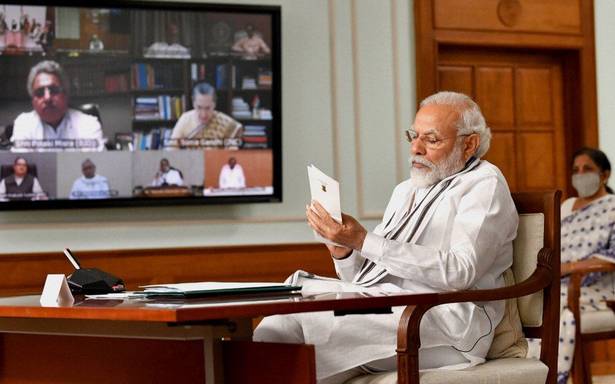Prime Minister Narendra Modi on Friday told an all- party meet called by him that no outsider was inside Indian territory in Ladakh nor had any border post of the Indian Army captured by outside forces, adding that the 20 Indian soldiers who had died in the violent face- off between Indian and Chinese troops had “taught a lesson to those who had cast an eye on our Motherland before laying down their life”.
He said this in his closing remarks in a meeting attended by presidents of over 15 political parties, who while expressing support to the country, the armed forces and Prime Minister Modi’s government on tackling the situation at the east Ladakh border said status quo ante on the borders must be restored.
Also read | China lays claim to entire Galwan Valley
Defence Minister Rajnath Singh, External Affairs Minister S. Jaishankar and Finance Minister Nirmala Sitharaman were also present at the meeting as well as Foreign Secretary Harsh Shringla.
Sources told The Hindu that while Dr. Jaishankar made a presentation over the diplomatic issues surrounding the event, Mr. Singh responded to direct questions by party leaders and denied that any intelligence failure had taken place.
“The meeting was to take party leaders through the sequence of events and what has been done to deal with the issue, but apart from the Foreign Minister’s presentation it was not a hugely detailed briefing,” said one Opposition leader.
Also read | Indian, Chinese troops face off in Eastern Ladakh, Sikkim
“Rajnath Singh answered some questions, especially the ones put by Congress president Sonia Gandhi, but denied that any intelligence failure had taken place,” said the source.

In fact, Mr. Modi’s closing remarks at the meeting (telecast on Doordarshan) made the point that intensive patrolling due to improve infrastructure and supply lines on the borders had raised the frequency of such clashes.
Better infrastructure
“For the last few years we have prioritised developing infrastructure, easing supply lines and equipment. Because of the new infrastructure especially at the Line of Actual Control (LAC) our capacity for patrolling has increased an

